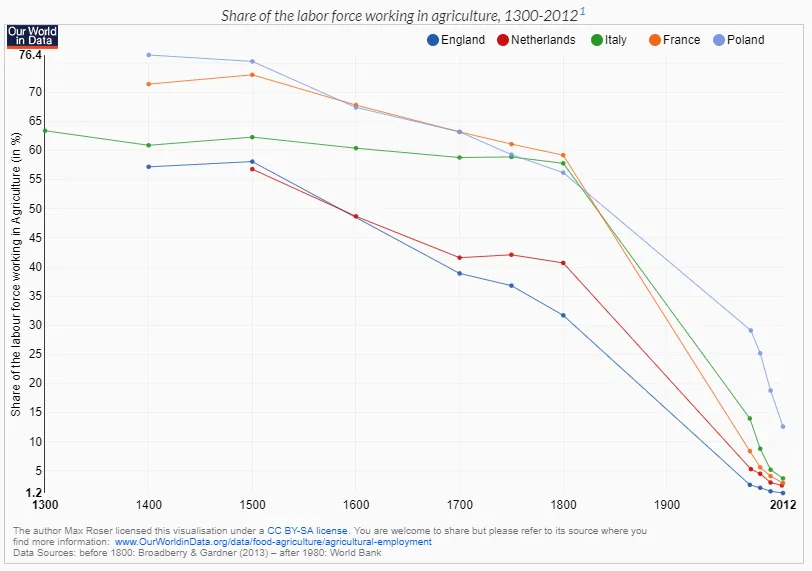In many of my writings, I try to frame what the pace of technological change is. At this point it is all guesswork since things are moving so rapidly.
Often when people hear that things are changing, they believe this is the first time it happened. While the overall pace of technological change is at an all time high, it is not without reference in the past.
Agriculture
Agriculture is one of the oldest professions (right after you know-what). We always had to feed ourselves and for much of history, there were two choices: kill something or grow it. This was long before the days of processed foods full of chemicals that were made in a laboratory.
Naturally, when feeding people throughout history, it took a lot of labor. After all, automating the growing of food is not easy. There are a lot of variables to consider.
Nevertheless, we did see the mechanization of that industry. Here is a chart from Ourworldindata.org:

Notice how the number of people working in the agriculture industry plummeted during the 20th century. It was a trend that started long before that but it is interesting that is coincided with a massive explosion in the global population. This means there were many more mouths to feed yet we were still able to significantly reduce the workforce.
The percentage of the population employed in agriculture has declined from 40 to 60% in 1700, to less than 2% today. Between 1900 and 2015, the number of people employed in agriculture in the US declined from 12 million to 2 million, a period in which US farm output (as well as total population) quadrupled:
More output with less people. The only way to get that is through the advancement of technology.
Of course, that means the more recent advancements saw a greater impact:
From 1940 to 1960 alone, Richard Day estimates that the labor required per bushel of cotton was reduced by 90%. The introduction of the tomato harvester reduced the labor required to harvest tomatoes by 50% between 1965 and 1973:

Source
That is a radical change to a couple different sectors in a relatively short period of time. For the cotton industry, it took two decades for 90% of the people to NOT be needed. It was less than a decade for tomato pickers to see a 50% reduction.
These are important lessons to keep in mind.
Technological Unemployment
People always make the mistake of forgetting that this happened before. Thus, they overlook the fact that we are now dealing with more powerful technology. This means that, in spite of taking on serious challenges, things can move just as quickly.
Making progress in the agriculture industry is not easy. Each crop is different meaning that is nothing standardized. All terrain is variable meaning it is not an easy set up like in factories. We also see planting over hundreds of acres. A variety of weather conditions have to be dealt with.
Yet we see the result clearly.
Once the technological breakthrough happens, things can then move quickly. There are a number of industries just primed to be disrupted in this manner. Right now it looks like a lengthy process but, in a decade or two, we will see the results.
We know that autonomous driving seems like an ever evasive idea. In spite of the setbacks, here is one thing for certain: they will figure it out. This is not a matter of if but when. Full self driving vehicles, especially trucks, are in our future.
Once that happens, look for the number of jobs where people drive for a living to drop at a rate resembling tomato pickers. We will lose half those jobs in under a decade.
Another field is construction. We still basically build houses the way we did a half century ago. It is still a labor intensive industry employing a large number of people.
The industry is still trying to figure out how to automate things. This is a technological challenge which has no clear answer. 3-D printing is one of the most promising options but it is not nearly enough. Nevertheless, here again, we can simply conclude they will figure it out.
Why is that?
We see a lot of similarities between construction and agriculture. Both present a lot more challenges than manufacturing or warehouse automation. The later was able to figure it out. We can only presume that those involved in construction research will also get there.
The Overall Impact
From our walk down memory lane, we know that the impact of technology is:
- more output
- less workers
We are able to produce more with less. This is why many are forecasting major issues with employment. If a shift takes place that resembles some of the moves in agriculture, we are talking about hundreds of millions of workers around the world suddenly who are redundant.
This doesn't only impact employment. It also has a major impact upon investing. Many like to buy commodities they believe will be in high demand. Right now, anything to do with battery technology fit into that category.
While there is no doubt the demand will only increase, many do not consider the supply side. Technology means that we are often able to increase supply at an exponential rate. The process of mechanizing things means output goes up significantly.
Keep this in mind the next time people take exception to some of the forecasts that are made regarding the next 10-20 years. Do not be quick to jump to the conclusion that it is impossible. In fact, there is a good chance we already saw that rate of change in another industry.
If you found this article informative, please give an upvote and rehive.

gif by @doze

logo by @st8z
